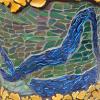New and Tasty Exhibits
The Extraordinary and the Delightfully Mundane
Dream Big: “Wish,” the latest exhibit curated by Didi Dunphy at the Gallery@Hotel Indigo and on display through March, includes the works of nine Athens-based and UGA-schooled professional artists aspiring to add a bit of glitter and gold to an otherwise dreary winter landscape.

Margaret Morrison's oil paintings are on display at the Gallery@Hotel Indigo through March.
Seeking to portray “the delightfully mundane in a scale of massive proportions,” the macro oil paintings of Margaret Morrison show tantalizing close-ups of realistic gummy worms and old-fashioned candies in bold stripes of red, yellow, blue and green. Claire Joyce’s “Latching,” a dazzling image of baby bottles lined up on a windowsill created with glitter, similarly attempts to present a seemingly ordinary human experience as significant and gleaming. “Ruby Reds,” a large-scale photograph of a pair of worn out sparkly red shoes by Jason Thrasher, makes an obvious allusion to Dorothy's ruby slippers in the Wizard of Oz. The inclusion of Thrasher’s other two photographs, “40 Watt Lights” and “Georgia Theatre Curtains,” reinforce how central aspiring musicians are to Athens culture, while the cartoon and basketball player oil paintings on portrait linens by Joshua Bienko may reference children’s dreams of becoming professional athletes.
The collection of jewelry designed by Mary Hallam Pearse—three brooches, a ring and a necklace made from silver, precious gems and digital prints on aluminum—are both visually striking and playful. Combining inspiration drawn from 18th–19th century “lover's eyes” and portrait jewelry with classic children’s dexterity games, each piece resembles a daguerreotype with little impressions that free-moving pearls can be rolled into.
Jennifer Crenshaw’s “Metallic Bloom,” a hand-woven cluster of geometric flowers resembling gold lace, and “Ice Cream Cone,” a photograph of a delicate hand-constructed paper wig by Nikki Nye and Amy Flurry of the Paper Cut Project, both suggest the desire to step away from mass-production and return to hands-on methods of creating art. Thom Houser’s “Murano 37:7-8 Reawakening” and “Murano 37:1 Resurgence,” large, moderately digitized close-ups of colorful broken glass in a landfill near Murano Glassworks on the Venetian island of Murano, raise issues surrounding recycling and the yearning to preserve the planet.
A Life-long Feminist: New York-based painter and printmaker Minna Citron had a lengthy and distinguished career as a social realist-turned-abstractionist at the forefront of significant artistic movements including the Fourteenth Street School and the first generation of Abstract Expressionists. “Minna Citron: The Uncharted Course from Realism to Abstraction” is on view at the Georgia Museum of Art through Mar. 3.
Many of Citron’s earliest urban realist works focused on the role of women in society, often in a satirical manner. Two lithographs from the ‘30s—“Beauty Culture?” a scene of women lounging around a salon called Scalpers getting perms and manicures, and “Demonstration,” a depiction of middle-aged women hovering around a young department store saleswoman demonstrating a cosmetic—criticize the shallowness of vanity and the trivial pursuit of achieving modern ideals of feminine beauty.
Over time, Citron’s energy for humorously confronting frivolous norms in society was redirected into producing strong statements about social inequities. “Need Women Age Limit 75,” for example, documents the hardship of elderly women seeking labor opportunities in a competitive and ageist job market. Aiming to record and promote women in path-breaking social roles, Citron created works such as “What the Well-Dressed Woman Wears to the Opera,” a 1943 charcoal drawing of two WWII-era women in Navy uniforms, which was part of the “New York in Wartime” series that marked the end of her early career in social realism.
As social and cultural movements slowly progressed, Citron’s style drastically evolved into abstraction, focusing on textured surfaces in printmaking, found-object assemblages and geometric compositions. Stressing the idea of “chance” as a philosophical element to her creative process, Citron incorporated randomly found materials like scraps of paper, paint can lids and yarn into her works to add three-dimensionality. “L’Arraignee,” an intaglio print from 1963, began with a frayed piece of rope Citron found while walking near her home. After running it through the press, the converging black lines against a magenta background suggested a long spider web, from which its title was derived.
Public Personas: I can’t help but wonder how Minna Citron would feel viewing “The Sorority Girl Project” by post-MFA Photography Faculty Fellow Kelly Kristin Jones, currently on display at the UGA Lamar Dodd School of Art in Gallery 101 through Thursday, Feb. 7. The series of a dozen 30 X 40-inch color prints, a play on formal portraiture, presents straightforward images of nicely dressed UGA sorority girls within the neutral setting of their houses. Documenting Greek culture with the intent of either perpetuating or challenging its common stereotypes would have been an obvious, albeit interesting, approach for a community with such a strong Panhellenic presence. Instead, Jones explores something much more complicated through her body of work: the mythology of perfectionism and the façade of self-curation. Rather than capturing candid shots that may have revealed girls at moments of vulnerability or unexpected exhibitions of individuality, the subjects are considerably posed and rigid, aware that their presentation in front of the camera lens will be shared with the general public. The inclusion of a film loop of a girl applying makeup is a particularly important aspect of the exhibit, in that it stresses the effort undertaken to maintain the best appearance possible. While the exhibit does not answer the mysteries of who the girls are behind their Greek guises, it does suggest the unsettling lengths to which many of them go in order to safely guard their images and reputations.
More by Jessica Smith
-

Art Around Town
A list of local art exhibits.
-

-

Art Around Town
A list of local art exhibits.









comments